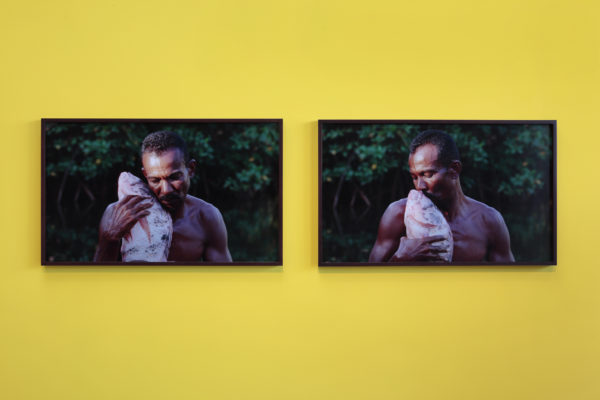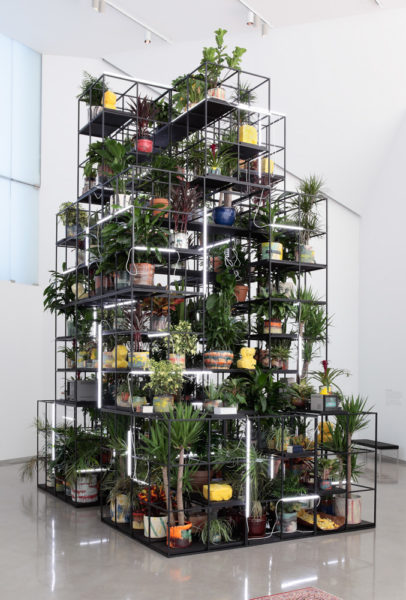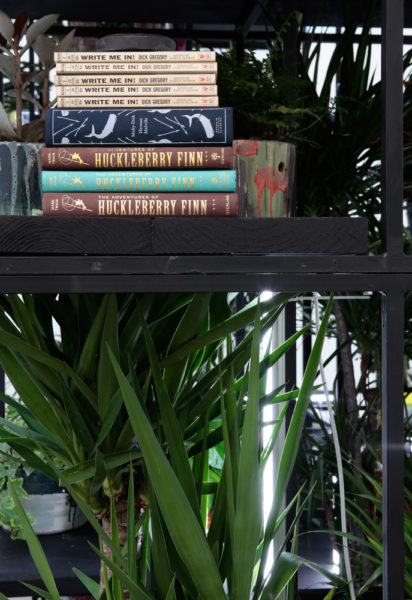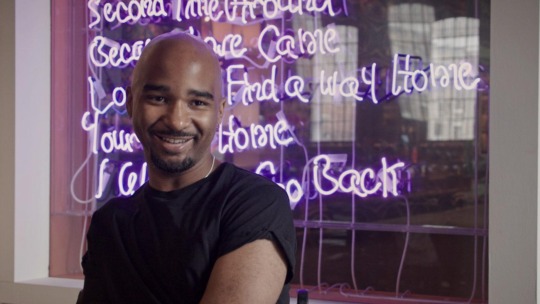
“The general consensus of the contemporary mass media is that the return of religion has emerged as the most important factor in global politics and culture today,” claims critic and theorist Boris Groys in his 2009 e-flux article “Religion in the Age of Digital Reproduction.” Groys goes on to describe this “revival of religion” as being primarily marked by the “language of repetition”: it is less the promotion of organized religion than that “religious attitudes have moved from culturally marginal zones into the mainstream,” meaning culturally marginal beliefs on both the Left and Right have become more religious in their fervor.
While he was thinking mostly about digital videos and images, Groys’s theory also provides insight into other forms of contemporary art. This revival of religion or ritual is a central impulse in two recently opened exhibitions on view at VCU’s Institute for Contemporary Art in Richmond. A group show, “Hedges, Edges, Dirt,” is dispersed over the two lower floors of the museum, with Rashid Johnson’s site-specific installation Monument located on the third floor. Throughout the museum, five artists investigate and demonstrate a contemporary religious impulse characterized by seeking meaning in repetition, ritual, and feelings of transcendence.
I am still flummoxed about the best path through the exhibitions. On one hand, starting from the ground floor provides an expectant progression upward. On the other hand, however, beginning Johnson’s Monument —the first work in the ICA’s new Provocation commission series— dramatically sets the stage for a downward route. Either path highlights the open spaces surrounding the works on view, a welcome change after the crowded “Declaration,” the ICA’s inaugural exhibition, in which the curators seemingly filled every space in the building with artwork. Now, more open space encourages the long periods of looking necessary for a richer encounter with the works on view.

In “Hedges, Edges, Dirt,” a contemporary religious impulse can be seen, for example, in the stacking of painted granite stones by Pascale Marthine Tayou in his installation Colored Stones, which commemorates the 1968 student uprisings in Paris yet also recalls roadside memorials comprised of stacked teddy bears and artificial flowers, or the Biblical tradition of the Israelites marking commemorative sites with stone altars. The sculpted forms and corresponding sounds in Julianne Swartz’s installation Sine Body (2017) combine the visual repetition of blown-glass-and-porcelain objects with layered audio tracks, creating an experience akin to something you might encounter in a Buddhist temple. While their slumped forms suggest individual bodily organs, the forms—which can appear to comprise a body with a glass head and ceramic torso—also register impressions of trauma.
Artist David Hartt uses cinematic repetition to show the monotony of the American landscape in his 2017 video The Last Poet, filming one city after another along the Eastern seaboard in a way that recalls Ed Ruscha’s iconic 1966 artist book Every Building on the Sunset Strip. In the large photo-tapestry Negative Space, the overall image composed by Hartt appears to break down into pixelated patches, creating the impression of an undulating, active photograph depicting industries and communities in flux. It recalls Andreas Gursky’s 1990 photograph Salerno 1, but while Gursky’s image emphasizes qualities of hyperreality and consumerism, Hartt draws the visitor’s attention to the cultural and material forces that shape collective ideologies, such as the church or cargo containers in the image.

Presented as stills from his 16 mm film O Peixe, Jonathas de Andrade’s images of grown men reverently cradling or kissing large fish before killing them seem foreboding at first glance, but there is something strangely tender in this intimate interaction between prey and hunter. Abbas Akhavan’s installation Untitled Garden (2008/2018) becomes an immersive critique of barriers, physically hedging visitors into a carefully choreographed entryway into the gallery.
Rashid Johnson’s installation Monument, however, is perhaps the most salient example of a contemporary religious impulse on view at the museum. Monument is everything its title suggests: colossal, formidable, masculine, aggressive, and awe-inspiring. Situated in a vaulted space, it brings to mind the verticality, transcendent aims, and pierced façade of Gothic architecture; the visitor is dwarfed by the grid-like structure, which appears almost like a three-dimensional expansion of Dan Flavin’s 1964 neon sculpture Monument (1) for V. Tatlin.

Johnson’s Monument owes obvious debts to the traditions of Minimalism developed by artists such as Flavin and Donald Judd, and to broader art-historical traditions connecting sculpture and notions of monumentality. Johnson’s installation disrupts this history, however, by featuring objects tucked away into the scaffold that, by their inclusion and careful placement, suggest a distinctly different type of ritual: sculptures made of shea butter, crudely carved into faces that Johnson calls his Anxious Men; crisp, fresh copies of Herman Melville’s Moby Dick and James Baldwin’s The Fire Next Time arranged in stacks; a screen showing Johnson’s early film of a black man performing at the Chinati Foundation; ferns and succulents in ceramic pots made—or, in Johnson’s language, “molested”—by the artist; and rod-shaped grow lights that reinforce the grid structure. While Monument positions Johnson’s work in conversation with largely white-dominated art-historical narratives, more broadly it also raises profound questions about cycles of life, death, and memory.
For the installation’s opening reception, Johnson invited the gospel choir from Fifth Avenue Baptist Church in Richmond to perform alongside Monument. Circling the structure, the eight choir members’ voices permeated the space, singing, “Some bright morning when this life is o’er, / I’ll fly away / to that home on God’s celestial shore; / I’ll fly away.” Johnson conceptualized the choral performance as a collaboration with the structure, but in practice the connection between the voices and the installation seemed unfulfilled.
In Richmond, the former capital of the Confederacy, Civil War memorials line the appropriately named Monument Avenue. As has recently been the case in other Southern cities such as Chapel Hill and New Orleans, Richmond’s residents are caught in a fierce public debate about what to do with these Confederate monuments. According to the Southern Poverty Law Center, 1,740 Confederate monuments still exist in the United States—and not just below the Mason-Dixon line. What makes Johnson’s Monument powerful is not its location but the way in which it challenges visitors to reconsider the appearance and role of monuments today. Unlike the controversial statuary lining Monument Avenue, Johnson’s installation has a temporary lifespan, and its iconography is simultaneously organic, deeply personal, and boldly abstract.

In James Baldwin’s The Fire Next Time, one of the texts Johnson includes copies of in Monument, Baldwin writes, “It is the responsibility of free men to trust and to celebrate what is constant—birth, struggle, and death are constant, and so is love, though we may not always think so—and to apprehend the nature of change, to be able and willing to change. I speak of change not on the surface but in the depths—change in the sense of renewal. But renewal becomes impossible if one supposes things to be constant that are not—safety, for example, or money, or power. One clings then to chimeras, by which one can only be betrayed, and the entire hope—the entire possibility—of freedom disappears.”
The title of Baldwin’s book comes from the lyrics of the traditional spiritual “Oh Mary Don’t You Weep”: “God gave Noah the rainbow sign / No more water but fire next time,” meaning that if America’s racial nightmare isn’t resolved, then the vengeance of God—”the fire next time”—is upon us. These two exhibitions at the ICA at VCU expand upon this sort of conceptually religious language, pushing viewers to consider the social evils—border walls, racism, historical forgetfulness, xenophobia—that imperil the possibility of spiritual rebirth in this country. If we are indeed able and willing to change, we must build monuments that propel us into a liberated future instead of confining us to our dark, violent past and present.
The group exhibition “Hedges, Edges, Dirt” is on view at the Institute for Contemporary Art at Virginia Commonwealth University in Richmond, VA, through January 6, 2019. Rashid Johnson’s Monument remains on view through July 2019.




